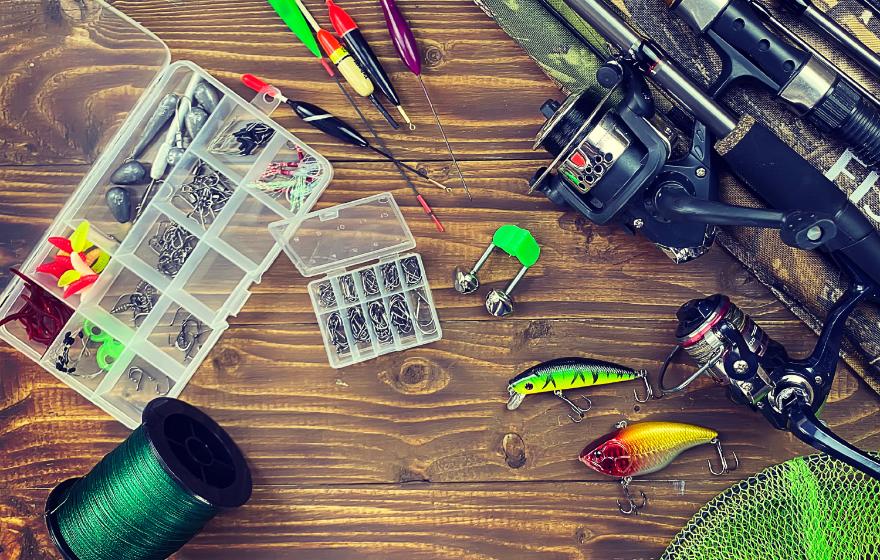- Division of Fisheries and Wildlife
Media Contact
Media Contact, MassWildlife

The holidays are over, most of the hunting seasons have passed, and the ice has yet to safely form. So, what can you do to keep occupied and stay connected to your outdoor passions? How about organizing and properly stowing away your open water fishing gear? It’s hard to find time to organize, but I have found that taking a little time to care for my gear can really pay off once spring rolls around. Here are a few simple things you can do to keep your fishing gear in tip-top shape.
Rod and reel combinations
Take everything out, remove any terminal tackle (lures or live bait rigs), then take the reel off the rod.
- Rod: Inspect the rod and look for issues like damaged guides or broken reel seats. This kind of damage can be repaired at a tackle shop, or you can browse the many online resources and videos to complete the repairs yourself. If you don’t find damage, wipe down the rod, reel seat, and handle. Put a little lubricating oil on the reel seat threads to keep it from rusting (no need to do this if it’s plastic).
- Reels: Depending on how much you fish, you may decide to change the line. If you only fish a few times each year, this isn’t necessary. If you’re on the water a lot, you should probably strip the line off and re-spool with new line. This is a fairly simple process with oodles of online videos to guide you through. Before storing, decrease the drag setting (line tension adjustor) to reduce strain on the drag gears. Wash the reel gently, especially if it’s been in salt water at all during the year. Wipe it down and lubricate all the moving parts with reel oil.
Reattach the reel to the rod. Store upright or laying down in a spot out of direct sunlight and extreme temperatures—garages and basements work just fine. There’s no need to re-rig the rod and reel with tackle. It’s best for the rod and the moving parts of the reel if you store it un-rigged.
Terminal tackle
Take a look at your terminal tackle–hooks, bobbers, weights, lures etc. Organize your tackle bag or box by removing loose fishing line, broken or rusted lures, pieces of soft plastic lures, cracked bobbers, rusty hooks, and other miscellaneous trash that has accumulated over the year (or years!). Put all the tackle back neatly in whatever arrangement works best for you. I like to keep things separated—live bait gear including hooks, bobbers, and weights are close together and lures are stored in a different area and organized by style or by target species. Always keep soft plastics in their original packaging, as these can melt or chemically bind to other plastic materials within your box.
Fishing tools
I don’t pack a ton of tools, but the ones I do carry are indispensable—a hook removal tool, nail clippers, a good knife, and perhaps a stringer and or a mouth gripping tool. It’s frustrating when you reach for those hemostats to remove a hook and they’re rusted solid and won’t move. Clean up your fishing tools and make sure they’re in good working order. If a tool is rusted solid and hasn’t been used in years, it might be a good idea to just toss it. However, if it’s only a bit of surface rust, a light sanding with steel wool and some lubricating oil should bring it back to life. Make sure to replace any tools you need before heading out in the spring.
Waders and boots
Even though waders and boots come in a variety of materials, the method for basic care and storage is the same for all types. Wash down your boots or waders and store them away from extreme temperatures and direct sunlight. Winter is the perfect time to patch leaks and mend straps. Large leaks are easily spotted, but smaller ones may be hard to pinpoint. Turn the waders inside out, dip a cotton swab in rubbing alcohol and wipe onto high-stress areas like the knees and along seems. The rubbing alcohol will evaporate quickly leaving a dark spot at the sight of any small holes. Circle the leak with a marker so you’ll know where to patch.
Hopefully these tips inspire you to get your fishing gear organization on! We are just a few short months away from trout stocking season and prime Massachusetts open water fishing. If you are daydreaming about getting back out on the water, you can pass the time by exploring MassWildlife’s Go Fish MA! digital map to find a new place to fish in the spring. You can also stop by the MassWildlife booth at the New England Fishing Expo in Marlborough (Feb. 2–4) or the Springfield Sportsmen’s Show (Feb 23–25).
–Jim Lagacy is MassWildlife’s Aquatic Education Coordinator and has been teaching people how to fish for the past 29 years.
